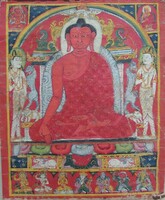Buddha & 'Buddha Appearance' in Himalayan Art

In Himalayan and Tibetan art the word 'buddha' can have two meanings. The first meaning belongs to the religious definition within Buddhism where 'buddha' means a completely enlightened being having reached the top of the Ten Bodhisattva Grounds (levels, stages) and progressed further to a 13th level known as complete Buddhahood.
In art 'Buddha Appearance' refers to figures that have the form of a buddha as defined by the early Buddhist literature describing the characteristics of a buddha such as the Thirty-two Major and Eighty Minor Marks of a Buddha. Typically buddha figures are facing forward, with a dot between the eyebrows, an ushnisha on the top of the head marked with a gold ornament, three lines under the neck, elongated earlobes, wearing the patchwork robes of a fully ordained monk and seated in the vajra posture with the right leg over the left. Buddhas can have different colours. Shakyamuni is usually depicted as golden in colour, Amitabha is red, Medicine Buddha appears blue, etc.
In Tantric Buddhist art there are many deities that are buddhas but do not appear in Buddha Appearance, such as Vajradhara, Vajrasattva and all of the meditational deities (ishtadevata) such as Hevajra, Chakrasamvara and Kalachakra. In Tantra well known subjects such as Tara are regarded as fully enlightened buddhas that have chosen to a appear in a peaceful goddess like form rather than Buddha Appearance.
Buddha Figures with Buddha Appearance:
- Shakyamuni Buddha
- Medicine Buddha
- Amitabha/Amitayus Buddha
- Vairochana Buddha
- Nagaraja Buddha
- Meru Shikara Buddha
- Muni Trisamaya Vyuha
- Buddhas of the Three Times (Dipamkara, Shakyamuni, Maitreya)
- Maitreya: Buddha of the Future
- Buddha's of the Six Realms (Wheel of Life Paintings & the Guhyagarbha Tantra)
- Seven Supreme Buddhas
- Buddhas of the Ten Directions
- Thirty-five Confession Buddhas (Three Systems of Depiction)
- One Thousand Buddhas of this Age
Buddhas that DO NOT have typical Buddha Appearance:
- Five Symbolic Buddhas of the Vajrayana Tantra System (when depicted with crowns, jewel ornaments, fine clothes & consort deities)
---- Vairochana
---- Amitabha
---- Akshobhya
---- Ratnasambhava
---- Amoghasiddi
- Vajradhara
- Vajradharma (including Vira Vajradharma)
- Vajrasattva
- Samantabhadra (Kuntu Zangpo)
Human Figures with Buddha Characteristics:
- Rahula (arhat): commonly depicted with an ushnisha on the crown of the head
- Nagarjuna: commonly depicted with an ushnisha
- Garab Dorje: commonly depicted with an ushnisha
- Sakya Pandita: commonly depicted with an ushnisha
